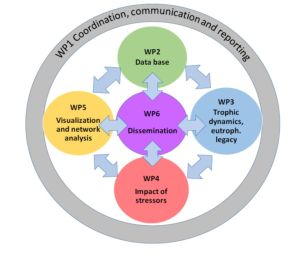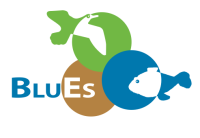The BluEs project will study the impacts of multiple stressors on food webs and nutrient cycles in the two largest German estuaries, the Odra (Baltic Sea) and Elbe (North Sea) estuaries, by combining field work, laboratory experiments and modelling. A comprehensive investigation of the effects of multiple stressors including eutrophication, contamination, and climate change on the biota of the Odra and Elbe estuaries will be carried out by a group of scientists, government representatives and nature conservationists. Both estuaries suffer from climate change and human activities including dredging of the navigational channels, which causes sediment loss, turbidity, as well as the release of nutrient and contaminants. Stakeholder involvement will ensure knowledge transfer and development of the science-based recommendations for sustainable development and use of estuarine systems.
The project consists of six work packages (WP) embraced by coordination (WP1) and as center piece the management and dissemination (WP6) ensuring continuous exchange between scientific work and stakeholder interaction.
WP1 oversees the work in all other packages, and help ensuring that all goals are achieved. Reporting to the funding agency and kickoff and annual meetings with partners will be organized. External partners will be involved by video conferences and invitations to project meetings.
Contributions from IOW, UHRO, HZG, HAW, UHH, EI and JV.
WP2 will coordinate the provision of data via a relational database under a unified, consistent and workable through project partners and work packages.
Contributions from IOW, HZG, HAW, UHH and BjG.
WP3 focusses on the study of trophic dynamic and eutrophication legacy. Several field trips and cruises are planed within this work package in the Elbe and Odra estuaries to sample all food web components from nutrient to fish and birds. Stable isotopes analyses will be carried out on these samples to study food web structure.Detailed analyses of food ecology and growth as an indicator of food availability are carried out on fishes, the most important vertebrate group in estuaries.
Contributions from HZG, IOW, UHH and VJ.

WP4 will specifically look at the impact of stressors such as temperature, nutrient load, oxygen concentration, and contaminants, on microbial community and key stones organisms in the food web though laboratory experiments.
Contributions from HZG, IOW, HAW, BjG and UHRO.
WP5 will provide a holistic approach by integrating results from WP 2, 3 and 4. Two different models will be used focusing a) ecological networks of the food web at both estuaries and different sites experiencing different pressures and b) fuzzy cognitive maps to visualize the knowledge of cause-effect relationships and to support efficiently solving problems in areas such as decision making, system control, and time series prediction. The users (tourism and fisheries associations) point of view can thus be integrated in the future management of estuarine system.
Contributions from IOW, UHRO, HZG, HAW, UHH, EI and JV.
WP6 wil luse results from WP2 to 5 to help management decision making by providing information and recommendations to stakeholders.
Contributions from EI, IOW, UHRO, HZG, HAW, UHH and JV.


